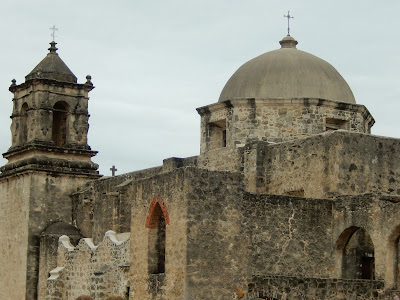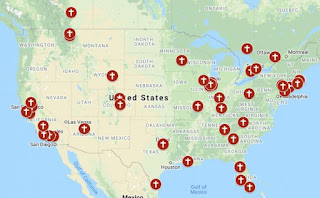 |
| Mission San Jose, Photo by Angela Loria on Unsplash |
Francisco “Poncho” Villa was a general in Mexico’s communist revolution (1910-1920). His daring and ruthlessness helped to usher in the infamous Mexican Constitution of 1917 which became a model for the Russian Bolsheviks a year later.
 |
| Francisco "Poncho" Villa |
The Mexican Revolution started as President Porfirio Diaz grew weak after 31 years in office and rigged an election to “win” against Francisco Madero with 99% of the vote. This touched off a 10-year power struggle among several rivals. Most of the warlords assassinated one another. The end of the revolution is dated to the surrender of Poncho Villa.
The military history is less consequential than the resulting Constitution of 1917. Only 30% of those attending the constitutional convention had actually fought in the revolution. Over half had university degrees and were steeped in the Marxist philosophy popular in that day. The resulting constitution had disastrous effects on Mexico and her people.
Three of its 137 articles stand out. Article 3 made a secular public education mandatory. Article 27 declared that the government, alone, was the original owner of all land and water in Mexico. It could seize and redistribute private property at will. Article 123 seized power over the work force. It instituted a national minimum wage, controlled how many hours any person could work, and mandated insurance.
These three articles are highlighted by the U.S. Library of Congress web site. Students of American government should note how remarkably different the Mexican Constitution is from that of the United States. Government indoctrination of children, wage and price controls, and infringement on property rights are the bread and butter of Marxist revolutionaries, not a just and free society.
The Constitution also stripped the Church of any property that the government deemed not “necessary.” Labor laws were used to regulate how many priests could be employed in any given region. Hundreds were removed from parishes with the goal of one priest per 30,000 parishioners.
Article 130 instituted a strict “separation of Church and state.” Foreign-born priests and ministers were deported. Those that remained were forbidden from holding public office or speaking about politics. If they were arrested for any offence, the constitution specifically denied clerics the right to a jury trial.
Article 24 dealt with religious freedom in this way: “Every man shall be free to choose and profess any religious belief as long as it is lawful and it cannot be punished under criminal law.” This left the door wide open to passing laws that forbade anything from wearing religious garb, to religious speech in public. In fact, that article went on to spell out that Christians could only worship behind closed doors. Keep this in mind the next time you hear someone say that the First Amendment grants “freedom of worship,” rather than “free exercise of religion.”
Exclusion from jury trial meant that publicly religious people could be arrested and executed on the spot. The dominant religion in Mexico was Roman Catholicism. The Church was slow to recognize the threat, and was content to live under the radar for several years after the 1917 Constitution was adopted.
 |
| Plutarcho Calles |
In 1926 a group of 400 parishioners retook a church in Guadalajara. After the parishioners ran out of ammunition and surrendered, the government stormed the church and killed the priest and his vicar. This was the opening skirmish in the Cristero War.
Cristero is a name deriving from the last words of Father Rodrigo Alemán. With a noose around his neck, his executioners shouted at him, “who lives?” He responded “Cristo Rey” (Christ the King.) They tightened the noose and repeated the process three times until he died with this confession on his lips.
Cristo Rey became the rallying cry of a war that claimed 90,000 lives over three years. It was ended when the government agreed to back off from enforcing all of the anti-religious provisions of the 1917 constitution. Even then, the armistice was broken and thousands of Cristeros were slaughtered in the aftermath.
The anti-religious provisions themselves remained in Mexico’s Constitution until 1992. Only then were religious organizations given legal status and property rights. And, only then were restrictions lifted on the number of priests each province could have.
A century after the Marxist revolution, Mexico is still paying a steep price. The country’s population of 15 million was decimated. The economy was flattened. Religious and family life was devastated. This, especially, continues to have its oppressing effect.
 |
| Churches attacked in America from May 25-July 24 |
Best-selling author, Eric Metaxas has explained, “You saw this in the French Revolution. There was a hatred—at the bottom of it—of God, of any kind of authority.” He might have added that we saw this in the Mexican Revolution, as well.
Marxism refuses to admit individual responsibility as a cause of social problems. Instead, it locates all problems in impersonal classes and target groups that must be eradicated. In order to preach this new religion, the first thing it must do is put down Christianity. This has happened whenever and wherever Marxism raises its murderous ideology.
What happened south of our border could also happen here. Property rights (including gun rights), free enterprise, virtuous education and religious liberty are not merely isolated special interests. They form an integrated worldview where personal responsibility to love the neighbor stands as a bulwark against Marxism’s blind rage against disfavored groups.
Ideas have consequences. Evil ideas have evil consequences. Now is the time to understand the ideas that are driving the current wave of senseless destruction. They are not new or untried. They have been infecting and destroying societies for over a century. It’s time to take them seriously.

This comment has been removed by a blog administrator.
ReplyDeleteconventional wisdom
ReplyDelete